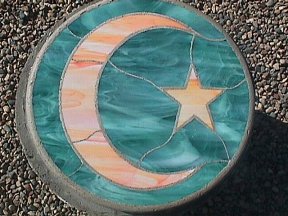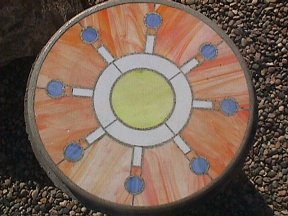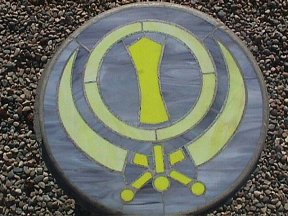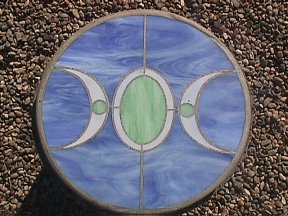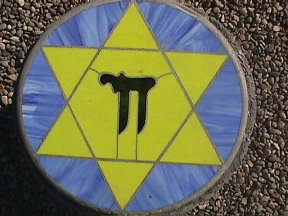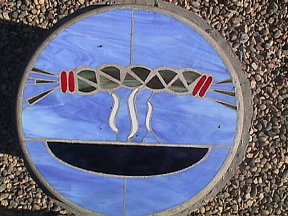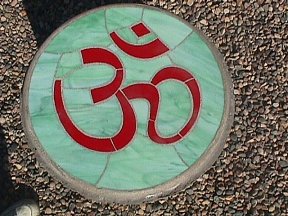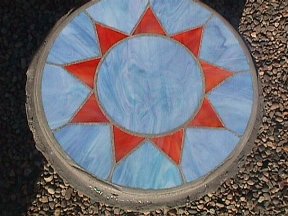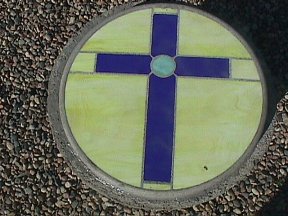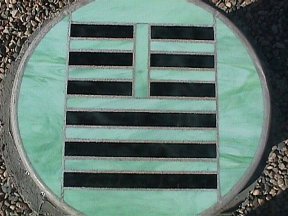The
Religion Department at Brandon University has created a Labyrinth of
Peace, the only one of its kind in Canada, with the purpose of promoting
religious tolerance and peace.
"In building the Labyrinth of Peace, we hope to
raise awareness about the many religions, cultures, and communities
that co-exist within our region, and the symbols they use to represent
themselves," said Dr.
Alison Marshall, coordinator of the Labyrinth of Peace project, and
professor of religion at Brandon University. "The labyrinth will be
constructed in the shape of a mandala (circular-like pattern) with the
religions of Brandon being depicted around the perimeter of the structure.
The students chose this particular pattern because it displays the many
routes to the center, paralleling the way in which each religion offers
its own pathway to the divine."
Labyrinths have been built all over the world as complex
pathways leading to a center point and exit. Some say that the use of labyrinths
as religious pathways has its origins in 12th Century Europe, when Christians
walked around the pathways of labyrinths during sacred pilgrimages. Although
there are many labyrinths designed to express one religion, few, if any,
exist in Canada and the world that combine many different religions and
cultures with a view to promoting religious tolerance and peace. The idea
to build the Labyrinth of Peace in Brandon was inspired by a trip to New
Harmony, Indiana, when Dr. Marshall and her husband walked around the maze
built as a memorial to the Harmonists who lived in New Harmony between
1814-1824 and sought to create a utopian society. For more information
about labyrinths around the world visit the Labyrinth Society website :
www.Labyrinthsociety.org
Islam—Crescent and
Star: The faith of Islam is symbolized by the Crescent and Star.
The Crescent is the early phase of the moon and represents progress.
The star signifies illumination with the light of knowledge. Islam
by definition means submission and has the extended meaning of peace.
Buddhism—Dharma Wheel: Buddhism's
Dharma Wheel and its eight points symbolize the various types of living
(Eightfold Path) that lead to a peaceful existence in the world.
The Buddha, reputed to have lived in India during the 6th century BCE,
is an example of individual peace and the end to suffering through enlightenment.
Sikhism—Khanda: The Sikh symbol,
the Khanda, is composed of the double-edged sword in the centre, surrounded
by the circle (chakra), with the kirpan on both sides. It represents
union with God, and the importance of divine knowledge, action, and devotion
while living peacefully.
Earth Religions—Three
Goddess symbol: The Three Goddess symbol uses the waxing, full and
waning moons to illustrate the three stages of a woman's life. Wiccans
believe all living things possess a soul, and therefore all have the right
to live.
Judaism—Chai
symbol within the Star of David: The Jewish belief in peace and
harmony is reflected in the integration of Chai (life and good luck) with
the Star of David, a traditional symbol of the Jewish peoples. “Judaism
may be characterized as a religion of deed, a ‘Way’ of action by which
people attempt to respond to God's teachings and principles.” (Bruce
Sarbit).
Native Religions—Sweet
Grass in a Smudge Bowl: Smudging is a ritual of purification performed
before any ceremony or sacred rite. According to Native religious
beliefs, human beings should strive to live each day in balance and harmony
with themselves and other parts of creation.
Hinduism—Aum: The symbol Aum
is the closest verbal expression of Brahman, the universal essence of the
soul. This symbol is often chanted during puja (worship), and is
visually represented on many objects.
Baha’i—Nine Pointed Star: The
symbol of the Nine Pointed Star reflects the Baha’i faith’s high regard
for world harmony, peace, and equality. Baha’is strive to “make humanity
into one global family and the earth into one homeland”
Christianity—Cross: The Cross
is a representation of Jesus whom Christians accept as Christ (the Messiah)
and the Son of God. They believe that Jesus died on the cross to
deliver all people from their sins, and emphasize love, peace, service,
and forgiveness. They recognize the Trinity of God the Father, God
the Son, and God the Holy Spirit.
Daoism—Tai symbol of Peace:
Daoism, a religion of China, is represented by the symbol of the hexagram
Tai from the Classic of Changes (I-Ching/Yijing). It means peace
and indicates harmony between earth (the three broken lines) and heaven
(the three unbroken lines).
Visit the Official Site at:
http://www.brandonu.ca/Academic/Arts/Departments/Religion/stainglass.html
The Religion Department ~ Brandon
University ~ Brandon, MB, Canada
Favourite
Quotations
-
One falsehood spoils a thousand truths.
--African Proverb
-
Some people handle the truth carelessly;
Others never touch it at all. --Anonymous
-
Sweet is war to those who have never
experienced it. --Latin Proverb
-
We few, we happy few, we band of brothers;
For he today that sheds his blood with me; Shall be my brother. --Shakespeare,
"Henry V"
-
I will charge thee nothing but the
promise that thee will help the next man thee finds in trouble. --Mennonite
Proverb
-
Great opportunities to help others
seldom come, but small ones surround us every day. --Sally Koch
-
It takes all sorts to make a world.
--English Proverb
-
The main dangers in this life are the
people who want to change everything - or nothing. --Lady Astor
-
The weaker the argument, the stronger
the words. --American Proverb
-
A baby is an angel whose wings decrease
as his legs increase. --French Proverb
-
A sunrise is God's way of telling the
world to lighten up. --Roadside Church Sign
-
I'm not afraid to die. I just
don't want to be there when it happens. --Woody Allen
-
Only love gives us the taste of eternity.
--Jewish Proverb
-
No love, no friendship can cross the
path of our destiny without leaving some mark on it forever. --Francois
Mauriac
-
Character is what God and the angels
know of us; reputation is what men and women think of us. --Horace Mann
-
Treat the world well. It was
not given to you by your parents. It was willed to you by your children.
--Kenyan Proverb
-
The words of God are not like the oak
leaf which dies and falls to the earth, but like the pine tree which stays
green forever. -Native American Proverb
-
Certain thoughts are prayers.
There are moments when, whatever be the attitude of the body, the soul
is on its knees. --Victor Hugo
-
Turn your face to the sun and the shadows
fall behind you. --Maori Proverb
-
If you have much, give of your wealth;
if you have little, give of your heart. --Arab Proverb
-
If you put out another's candle, you
also will be in the dark. --German Proverb
-
The greatest good you can do for another
is not just to share your riches but to reveal to him his own. --Benjamin
Disraeli
-
Do good and don't worry to whom. --Mexican
Proverb
-
Teach us to give and not to count the
cost. --Ignatius Loyola
-
A man is judged by his deeds, not by
his words. --Russian Proverb
-
Soft words are hard arguments. --Thomas
Fuller
-
The eyes are the mirror of the soul.
--Yiddish Proverb
-
Could a greater miracle take place
than for us to look through each other's eyes for an instant? --Henry David
Thoreau
-
Man proposes, God disposes. --Chinese
Proverb
-
How to make God laugh. Tell him your
future plans. --Woody Allen
-
Help thy brother's boat across, and
lo! thine own has reached the shore. --Hindu Proverb
-
It is one of the beautiful compensations
of this life that no one can sincerely try to help another without helping
himself. --Charles Dudley Warner
-
The difference between adults and children
is that adults don't ask questions. --American Proverb
-
Life is a candle before the wind. --Japanese
Proverb
-
You only live once. But if you
work it right, once is enough. --Fred Allen
-
In time of war the devil makes more
room in hell. --German Proverb
-
A child's tear rends the heavens. --Yiddish
Proverb
-
What's done to children, they will
do to society. --Dr. Karl Menninger
-
Old age takes away from us what we
have inherited and gives us what we have earned. --Gerald Brenan
-
Since God could not be everywhere,
he created mothers. --Jewish Proverb
-
The whole world is a dream, and death
the interpreter. --Yiddish Proverb
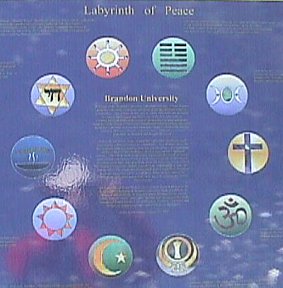
 .
.
